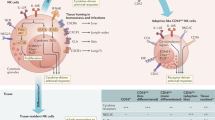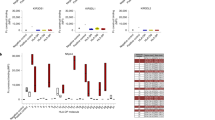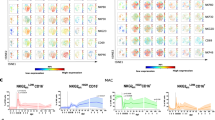Abstract
Natural killer (NK) cells expressing inhibitory receptors that bind to self major histocompatibility complex (MHC) class I are 'licensed', or rendered functionally more responsive to stimulation, whereas 'unlicensed' NK cells lacking receptors for self MHC class I are hyporesponsive. Here we show that contrary to the licensing hypothesis, unlicensed NK cells were the main mediators of NK cell–mediated control of mouse cytomegalovirus infection in vivo. Depletion of unlicensed NK cells impaired control of viral titers, but depletion of licensed NK cells did not. The transfer of unlicensed NK cells was more protective than was the transfer of licensed NK cells. Signaling by the tyrosine phosphatase SHP-1 limited the proliferation of licensed NK cells but not that of unlicensed NK cells during infection. Thus, unlicensed NK cells are critical for protection against viral infection.
This is a preview of subscription content, access via your institution
Access options
Subscribe to this journal
Receive 12 print issues and online access
$209.00 per year
only $17.42 per issue
Buy this article
- Purchase on Springer Link
- Instant access to full article PDF
Prices may be subject to local taxes which are calculated during checkout






Similar content being viewed by others
References
Lanier, L.L. NK cell recognition. Annu. Rev. Immunol. 23, 225–274 (2005).
Lanier, L.L. Up on the tightrope: natural killer cell activation and inhibition. Nat. Immunol. 9, 495–502 (2008).
Binstadt, B.A. et al. Sequential involvement of Lck and SHP-1 with MHC-recognizing receptors on NK cells inhibits FcR-initiated tyrosine kinase activation. Immunity 5, 629–638 (1996).
Long, E.O. Negative signaling by inhibitory receptors: the NK cell paradigm. Immunol. Rev. 224, 70–84 (2008).
Nakamura, M.C. et al. Mouse Ly-49A interrupts early signaling events in natural killer cell cytotoxicity and functionally associates with the SHP-1 tyrosine phosphatase. J. Exp. Med. 185, 673–684 (1997).
Stebbins, C.C. et al. Vav1 dephosphorylation by the tyrosine phosphatase SHP-1 as a mechanism for inhibition of cellular cytotoxicity. Mol. Cell. Biol. 23, 6291–6299 (2003).
Peterson, M.E. & Long, E.O. Inhibitory receptor signaling via tyrosine phosphorylation of the adaptor Crk. Immunity 29, 578–588 (2008).
Kim, S. et al. Licensing of natural killer cells by host major histocompatibility complex class I molecules. Nature 436, 709–713 (2005).
Bix, M. et al. Rejection of class I MHC-deficient haemopoietic cells by irradiated MHC-matched mice. Nature 349, 329–331 (1991).
Fernandez, N.C. et al. A subset of natural killer cells achieves self-tolerance without expressing inhibitory receptors specific for self-MHC molecules. Blood 105, 4416–4423 (2005).
Anfossi, N. et al. Human NK cell education by inhibitory receptors for MHC class I. Immunity 25, 331–342 (2006).
Kim, S. et al. HLA alleles determine differences in human natural killer cell responsiveness and potency. Proc. Natl. Acad. Sci. USA 105, 3053–3058 (2008).
Yawata, M. et al. MHC class I-specific inhibitory receptors and their ligands structure diverse human NK-cell repertoires toward a balance of missing self-response. Blood 112, 2369–2380 (2008).
Yu, J. et al. Hierarchy of the human natural killer cell response is determined by class and quantity of inhibitory receptors for self-HLA-B and HLA-C ligands. J. Immunol. 179, 5977–5989 (2007).
Yokoyama, W.M. & Kim, S. Licensing of natural killer cells by self-major histocompatibility complex class I. Immunol. Rev. 214, 143–154 (2006).
Brodin, P., Lakshmikanth, T., Johansson, S., Karre, K. & Hoglund, P. The strength of inhibitory input during education quantitatively tunes the functional responsiveness of individual natural killer cells. Blood 113, 2434–2441 (2009).
Johansson, S. et al. Natural killer cell education in mice with single or multiple major histocompatibility complex class I molecules. J. Exp. Med. 201, 1145–1155 (2005).
Joncker, N.T., Fernandez, N.C., Treiner, E., Vivier, E. & Raulet, D.H. NK cell responsiveness is tuned commensurate with the number of inhibitory receptors for self-MHC class I: the rheostat model. J. Immunol. 182, 4572–4580 (2009).
Raulet, D.H. & Vance, R.E. Self-tolerance of natural killer cells. Nat. Rev. Immunol. 6, 520–531 (2006).
Lodoen, M.B. & Lanier, L.L. Natural killer cells as an initial defense against pathogens. Curr. Opin. Immunol. 18, 391–398 (2006).
Biron, C.A., Byron, K.S. & Sullivan, J.L. Severe herpesvirus infections in an adolescent without natural killer cells. N. Engl. J. Med. 320, 1731–1735 (1989).
Lodoen, M.B. & Lanier, L.L. Viral modulation of NK cell immunity. Nat. Rev. Microbiol. 3, 59–69 (2005).
Wagner, M., Gutermann, A., Podlech, J., Reddehase, M.J. & Koszinowski, U.H. Major histocompatibility complex class I allele-specific cooperative and competitive interactions between immune evasion proteins of cytomegalovirus. J. Exp. Med. 196, 805–816 (2002).
Pinto, A.K., Munks, M.W., Koszinowski, U.H. & Hill, A.B. Coordinated function of murine cytomegalovirus genes completely inhibits CTL lysis. J. Immunol. 177, 3225–3234 (2006).
Arase, H., Mocarski, E.S., Campbell, A.E., Hill, A.B. & Lanier, L.L. Direct recognition of cytomegalovirus by activating and inhibitory NK cell receptors. Science 296, 1323–1326 (2002).
Smith, H.R. et al. Recognition of a virus-encoded ligand by a natural killer cell activation receptor. Proc. Natl. Acad. Sci. USA 99, 8826–8831 (2002).
Adam, S.G. et al. Cmv4, a new locus linked to the NK cell gene complex, controls innate resistance to cytomegalovirus in wild-derived mice. J. Immunol. 176, 5478–5485 (2006).
Desrosiers, M.P. et al. Epistasis between mouse Klra and major histocompatibility complex class I loci is associated with a new mechanism of natural killer cell-mediated innate resistance to cytomegalovirus infection. Nat. Genet. 37, 593–599 (2005).
Kielczewska, A. et al. Ly49P recognition of cytomegalovirus-infected cells expressing H2-Dk and CMV-encoded m04 correlates with the NK cell antiviral response. J. Exp. Med. 206, 515–523 (2009).
Daniels, K.A. et al. Murine cytomegalovirus is regulated by a discrete subset of natural killer cells reactive with monoclonal antibody to Ly49H. J. Exp. Med. 194, 29–44 (2001).
Dokun, A.O. et al. Specific and nonspecific NK cell activation during virus infection. Nat. Immunol. 2, 951–956 (2001).
Hanke, T. et al. Direct assessment of MHC class I binding by seven Ly49 inhibitory NK cell receptors. Immunity 11, 67–77 (1999).
Merck, E., Voyle, R.B. & MacDonald, H.R. Ly49D engagement on T lymphocytes induces TCR-independent activation and CD8 effector functions that control tumor growth. J. Immunol. 182, 183–192 (2009).
Orr, M.T. et al. Ly49H signaling through DAP10 is essential for optimal natural killer cell responses to mouse cytomegalovirus infection. J. Exp. Med. 206, 807–817 (2009).
Koszinowski, U.H., Del Val, M. & Reddehase, M.J. Cellular and molecular basis of the protective immune response to cytomegalovirus infection. Curr. Top. Microbiol. Immunol. 154, 189–220 (1990).
Tay, C.H., Welsh, R.M. & Brutkiewicz, R.R. NK cell response to viral infections in β2-microglobulin-deficient mice. J. Immunol. 154, 780–789 (1995).
Sun, J.C., Beilke, J.N. & Lanier, L.L. Adaptive immune features of natural killer cells. Nature 457, 557–561 (2009).
Ziegler, H. et al. A mouse cytomegalovirus glycoprotein retains MHC class I complexes in the ERGIC/cis-Golgi compartments. Immunity 6, 57–66 (1997).
Reusch, U. et al. A cytomegalovirus glycoprotein re-routes MHC class I complexes to lysosomes for degradation. EMBO J. 18, 1081–1091 (1999).
Tripathy, S.K., Smith, H.R., Holroyd, E.A., Pingel, J.T. & Yokoyama, W.M. Expression of m157, a murine cytomegalovirus-encoded putative major histocompatibility class I (MHC-I)-like protein, is independent of viral regulation of host MHC-I. J. Virol. 80, 545–550 (2006).
Wu, M.F. & Raulet, D.H. Class I-deficient hemopoietic cells and nonhemopoietic cells dominantly induce unresponsiveness of natural killer cells to class I-deficient bone marrow cell grafts. J. Immunol. 158, 1628–1633 (1997).
Sun, J.C. & Lanier, L.L. Cutting edge: viral infection breaks NK cell tolerance to “missing self”. J. Immunol. 181, 7453–7457 (2008).
Sun, J.C. & Lanier, L.L. Tolerance of NK cells encountering their viral ligand during development. J. Exp. Med. 205, 1819–1828 (2008).
Tripathy, S.K. et al. Continuous engagement of a self-specific activation receptor induces NK cell tolerance. J. Exp. Med. 205, 1829–1841 (2008).
Velardi, A. Role of KIRs and KIR ligands in hematopoietic transplantation. Curr. Opin. Immunol. 20, 581–587 (2008).
Clausen, J. et al. Impact of natural killer cell dose and donor killer-cell immunoglobulin-like receptor (KIR) genotype on outcome following human leucocyte antigen-identical haematopoietic stem cell transplantation. Clin. Exp. Immunol. 148, 520–528 (2007).
Hsu, K.C. et al. Improved outcome in HLA-identical sibling hematopoietic stem-cell transplantation for acute myelogenous leukemia predicted by KIR and HLA genotypes. Blood 105, 4878–4884 (2005).
Miller, J.S. et al. Missing KIR ligands are associated with less relapse and increased graft-versus-host disease (GVHD) following unrelated donor allogeneic HCT. Blood 109, 5058–5061 (2007).
Sobecks, R.M. et al. Survival of AML patients receiving HLA-matched sibling donor allogeneic bone marrow transplantation correlates with HLA-Cw ligand groups for killer immunoglobulin-like receptors. Bone Marrow Transplant. 39, 417–424 (2007).
Yu, J. et al. Breaking tolerance to self, circulating natural killer cells expressing inhibitory KIR for non-self HLA exhibit effector function after T cell-depleted allogeneic hematopoietic cell transplantation. Blood 113, 3875–3884 (2009).
Acknowledgements
We thank J. Jarjoura for assistance with cell sorting; H. Consengco for assistance with retroviral transduction; H. Robson MacDonald (Ludwig Institute for Cancer Research) for RMA–Hm1-C4 cells; S. Vidal (McGill University) for Ly49H-deficient B6 mice; C. Lowell (University of California, San Francisco) for Me-v B6 mice; and J. Beilke and D. Hesslein for critical reading of the manuscript. Supported by the Cancer Research Institute (M.T.O.), the National Institutes of Health (AI066897) and the American Cancer Society (L.L.L.).
Author information
Authors and Affiliations
Contributions
M.T.O. planned and did experiments and wrote the manuscript; W.J.M. contributed to experimental design and provide essential reagents; and L.L.L. contributed to experimental design, data evaluation and writing of the manuscript.
Corresponding author
Ethics declarations
Competing interests
The authors declare no competing financial interests.
Rights and permissions
About this article
Cite this article
Orr, M., Murphy, W. & Lanier, L. 'Unlicensed' natural killer cells dominate the response to cytomegalovirus infection. Nat Immunol 11, 321–327 (2010). https://doi.org/10.1038/ni.1849
Received:
Accepted:
Published:
Issue Date:
DOI: https://doi.org/10.1038/ni.1849
This article is cited by
-
The Role of NK Cells and Their Exosomes in Graft Versus Host Disease and Graft Versus Leukemia
Stem Cell Reviews and Reports (2023)
-
Clonal expansion of innate and adaptive lymphocytes
Nature Reviews Immunology (2020)
-
Modulation of innate and adaptive immunity by cytomegaloviruses
Nature Reviews Immunology (2020)
-
NK cells are activated and primed for skin-homing during acute dengue virus infection in humans
Nature Communications (2019)
-
Key features and homing properties of NK cells in the liver are shaped by activated iNKT cells
Scientific Reports (2019)



